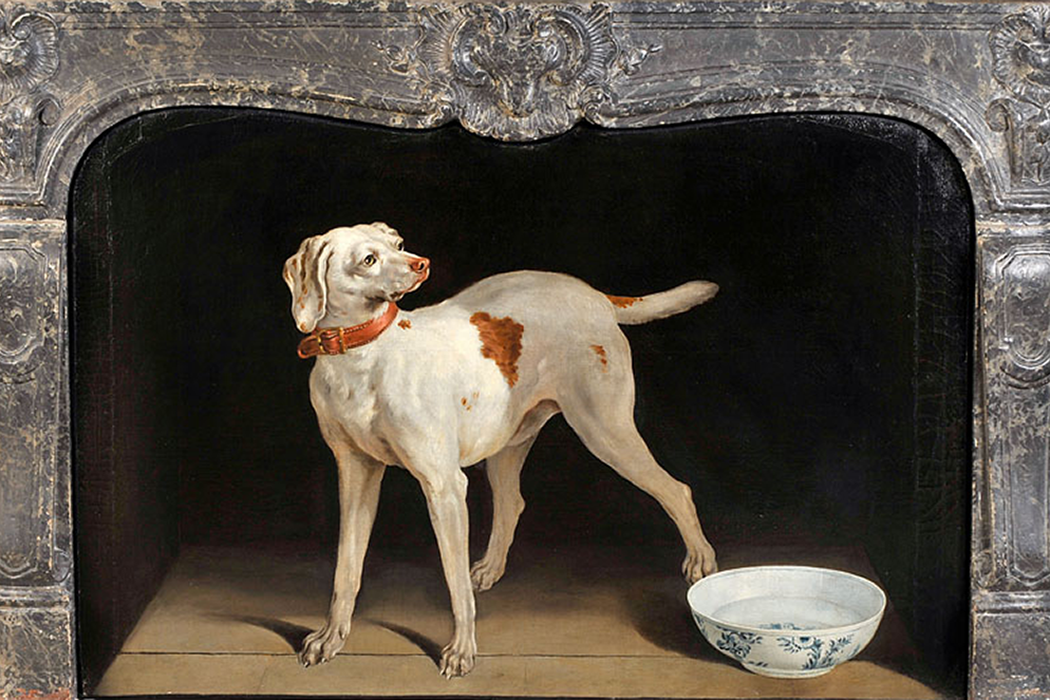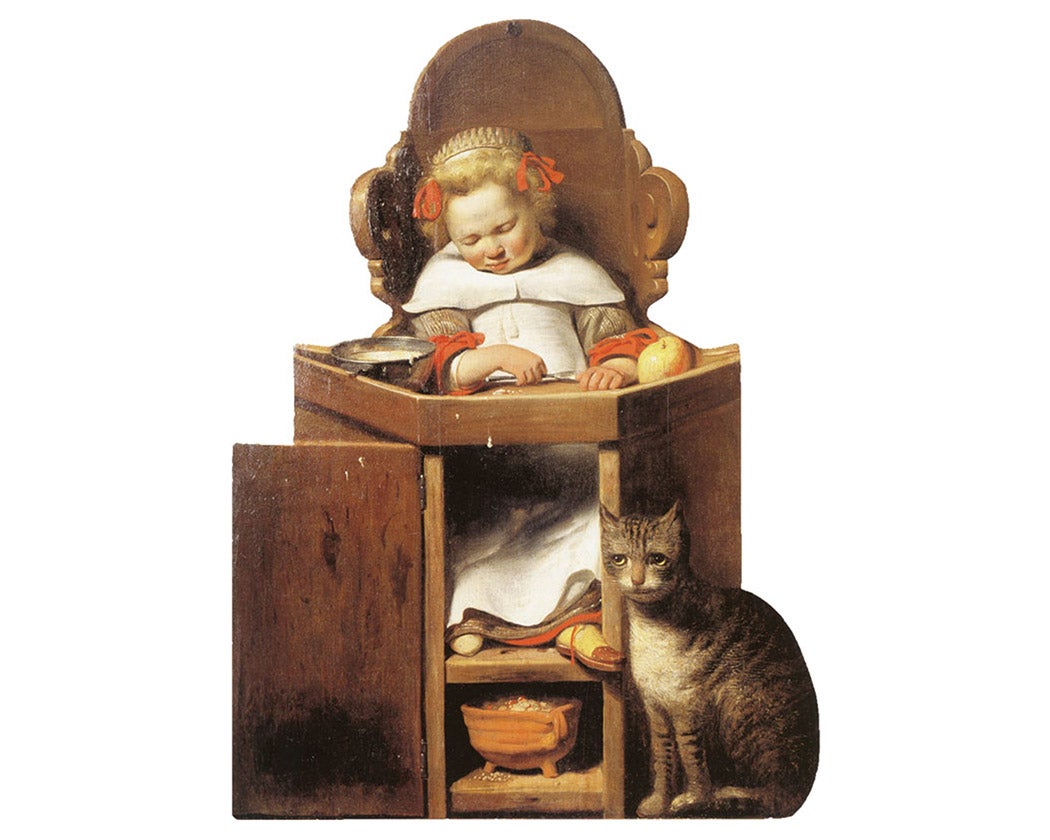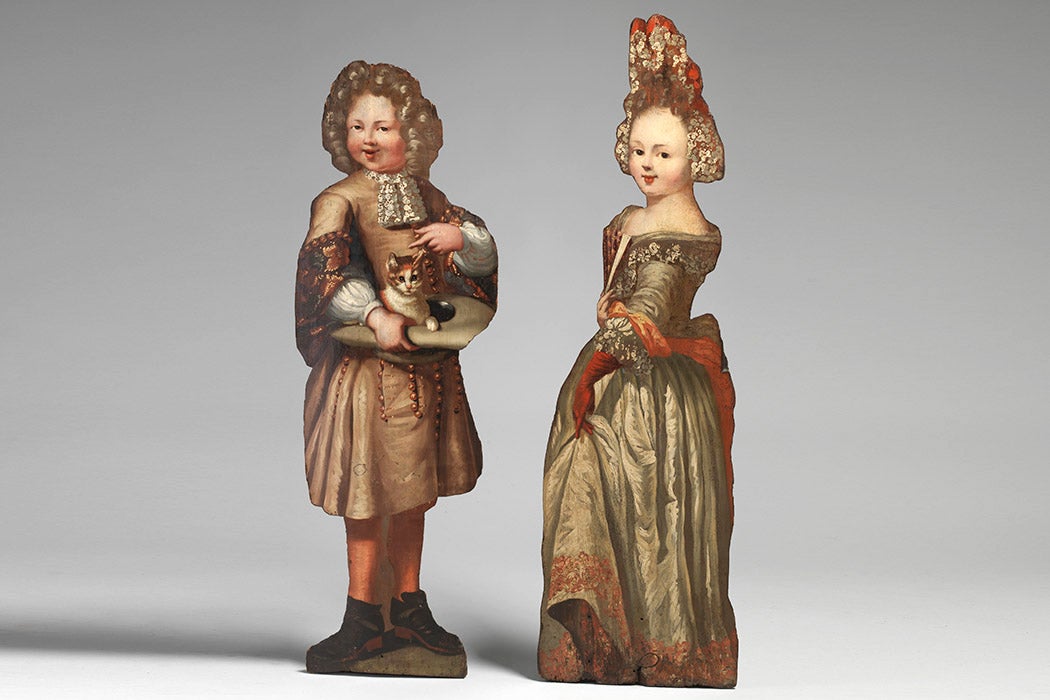Do you want to see the most luxurious version of a cut-out figure ever made? It’s called a dummy board, and it was a fad of the Netherlands in the mid-1600s and early 1700s. A far cry from the shiny cardboard celebrity stand-ups we see today, dummy boards were hand-painted in oils by artists skilled in trompe l’oeil.
You might think you’d never be fooled by one, but imagine rounding a corner to find a shadowy figure peering at you through the darkness, its face illuminated only by the flickering of distant candles. Your heart would probably stop for a second, until you realized what you took for a person was in fact a painting.
Then again, there are stories of people being more completely fooled: anecdotes of guests taking a cutout of a servant for a real one, even trying to slide a tip into its painted hands. More dramatically, Sally Wister, a young woman living through the early American Revolution recorded a prank she and her family played using a dummy figure. When their guest, Captain Tilly, arrived:
The first object that struck his view was a British soldier. In a moment his ears were saluted, “Is there a rebel officer here?” in a thundering voice. Not waiting for a second word, he darted like lightning out of the front door, through the yard, bolted o’er the fence. Swamps, fences, thorn-hedges and plough’d fields no way impeded his retreat. He was soon out of hearing. The woods echoed with, “Which way did he go? Stop him! Surround the house!” … We females ran down to join the general laugh… Figure to yourself this, Tilly, of a snowy evening, no hat, shoes down at heel, hair unty’d, flying across meadows, creeks, and mud-holes. Flying from what? Why, a bit of painted wood.
There’s a lot we don’t know about dummy figures. We don’t know the names of the artists who painted most of them, and the details of their use remain somewhat mysterious. Still, the main purpose of these figures seems to have been, quite simply, to amuse—although art historian Clive Edwards suggests that dummies in shapes of the soldiers were sometimes used as faux-guards in little-visited reaches of grand houses.

In addition to soldiers, the more common figures were children and maids. (Rembrandt supposedly pranked people passing by his house by setting a life-sized portrait of his maid in the window.) A few figures may have been portraits of members of the household in which they were propped up. Although we can’t know for sure, it’s easy to imagine someone commissioning a representation of a departed loved one or a venerable ancestor to watch over the home. Some artists even employed multiple layers of playful deception in the design of their dummy boards: one common type appears to be a maid on first glance, but on closer inspection is adorned with the clothes and jewelry of a high-society lady.
As Edwards observes, this obsession with trickery and illusion resonated throughout the visual culture of an era that abounded in playful artistic deceptions: cabinets full of secret compartments, serving dishes that disguised themselves as food, peep-boxes enclosing miniature rooms, and astonishingly hyper-realistic trompe l’oeil painting.

Consider the famous work of Cornelis Norbertus Gijsbrechts: Back of a Framed Painting. This painting seems, at first glance, to have been hung facing the wrong way–until you realize that the wooden frame, the cockeyed nails, and the peeling label are all part of the painting, meticulously replicated by the artist’s hand. Another of his paintings, which depicts an artist’s easel holding a still life and a palette, completely baffled me—I couldn’t quite believe it was really a flat image, until I zoomed in enough to see the cracks that had formed in the paint over the four intervening centuries.

The artist Samuel van Hoogstraten took it even further, peppering his whole studio with deceptively painted cutouts. Edwards shares a description of Hoogstraten’s work, penned the Dutch painter Arnold Houbraken:
Here an apple, pear or a lemon in a dish rack, there a slipper or shoes painted on a cut-out panel and placed in the corner of the room or under a chair. There were also dried, salted fish on a nail behind the door, and these were so deceptively painted that one could easily mistake them for actual dried fish.
It’s as if, at some point, the illusions escaped the canvas, spilling over the frame to invade the real world.
Weekly Newsletter
In his now classic essay Ways of Seeing, the Marxist art historian John Berger argues that the rise of oil painting in this era mirrored the rise of capitalism, writing:
Oil paintings often depict things. Things which in reality are buyable. To have a thing painted and put on a canvas is not unlike buying it and putting it in your house. If you buy a painting you buy also the look of the thing it represents… A patron cannot be surrounded by music or poems in the same way as he is surrounded by his pictures. It is as though the collector lives in a house built of paintings. What is their advantage over walls of stone or wood? They show him sights: sights of what he may possess.
At some point, though, these playful trompe l’oeil images seem to reverse the trend. You grasp at the painted image of a shoe, and it turns back into a flat canvas—a possession recedes into an illusion.







